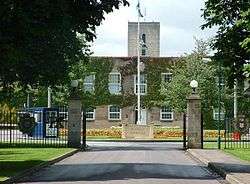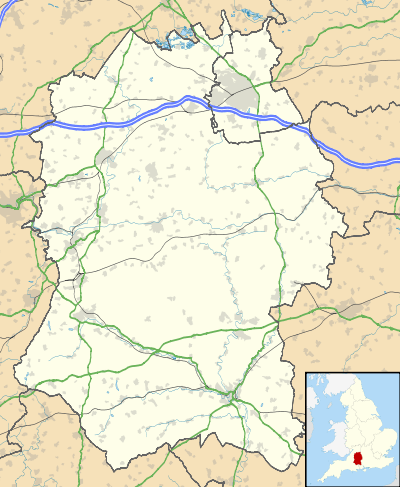Buckley Barracks
Buckley Barracks is a British Army barracks in Wiltshire, England, about 4 1⁄2 miles (7 km) north of Chippenham and 15 miles (24 km) west of Swindon.
| Buckley Barracks | |
|---|---|
| Near Chippenham in England | |
 Buckley Barracks | |
 Buckley Barracks Shown within Wiltshire | |
| Coordinates | 51°31′40″N 002°07′40″W |
| Type | Barracks |
| Site information | |
| Owner | Ministry of Defence |
| Operator | |
| Controlled by | Royal Logistic Corps |
| Site history | |
| Built | 1937 |
| In use | 1937–1992 (Royal Air Force) 1993 – present (British Army) |
| Garrison information | |
| Garrison | 9 Theatre Logistics Regiment, Royal Logistic Corps |
History
The barracks are located on the technical site of the former RAF Hullavington which closed on 31 March 1992.[1] On handover of the site to the Army in April 1993, it became known as Hullavington Barracks. The airfield part of the site was retained by the RAF and used for gliding until September 2016, when flying ceased.
In 1993 as part of the draw-down of the BAOR and withdrawal from Germany, 237 Signal Squadron, a field squadron of 14 Signal Regiment (Electronic Warfare) relocated from Celle, Germany to Hullavington. The Squadron moved again in June 1996 to rejoin the other two Squadrons (226 and 245 Signal Squadrons) that make up 14 Signal Regiment at Cawdor Barracks near Haverfordwest, Pembrokeshire.[2]
The barracks were renamed Buckley Barracks in 2003, after the Victoria Cross recipient Major John Buckley.[3]
Based units
The following notable units are based at Buckley Barracks.[4][5]
British Army
- Royal Logistics Corps
- 9 Theatre Logistics Regiment
- 90 Headquarters Squadron
- 66 Fuel and General Transport Squadron
- 84 Medical Supply Squadron
- 95 Supply Squadron
- 27 Theatre Logistic Regiment
- 91 Supply Squadron
- 9 Theatre Logistics Regiment
Role and Operations
The barracks are currently occupied by 9 Theatre Logistic Regiment of the Royal Logistic Corps (RLC).[6] As of 1 November 2018, there was 659 personnel assigned to the regiment.[7]
Future
In November 2016, the Ministry of Defence announced that the site would close in 2029 as part of the Better Defence Estate review.[8]
References
- March, Peter R. (1998). Brace by Wire to Fly-By-Wire – 80 Years of the Royal Air Force 1918–1998. RAF Fairford: Royal Air Force Benevolent Fund Enterprises. p. 160. ISBN 1-899808-06-X.
- "Regimental History - 14th Signal Regiment" (PDF). British Army. 2011. Archived from the original (PDF) on 24 November 2011.
- "Barracks to salute hero". This is Wiltshire. 8 May 2003. Retrieved 6 August 2014.
- "9 Regiment RLC". British Army. Retrieved 2 December 2018.
- "27 Regiment RLC". British Army. Retrieved 2 December 2018.
- "9 Regiment". British Army. Retrieved 14 August 2014.
- Lancaster, Mark (29 November 2018). "Army:Written question - 194616". UK Parliament. Retrieved 30 November 2018.
- "A Better Defence Estate" (PDF). Ministry of Defence. November 2016. p. 24. Retrieved 8 November 2016.